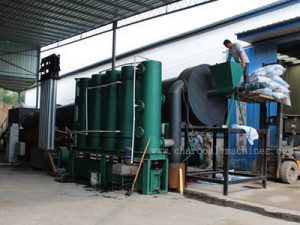Horno de carbonización continua, cuando la cáscara de coco se carboniza, primero debe triturarse y molerse hasta qué punto. Esto se puede determinar según las necesidades del cliente. El siguiente paso es el secado. El secado también es muy importante. La materia prima carbonizada general se carboniza. Cuando está seca, de lo contrario, el efecto de la carbonización no es bueno, el grado de secado de la cáscara de coco es de aproximadamente un 15 %-20 % de agua, no debe estar demasiado seca. Después del secado, se carboniza. También es muy importante. Si la carbonización no se domina bien, puede desecharse, convertirse en ceniza o no carbonizarse. En este momento, el uso del horno de carbonización es muy importante. ¿Cómo operarlo? Hay varios puntos a tener en cuenta.
1 La alimentación de la máquina de alimentación debe realizarse según la entrada de material de la máquina de carbonización. La condición de caída comienza y cierra la máquina de alimentación para reponer el material carbonizado. El material del puerto de alimentación inferior tampoco debe acumularse demasiado. Se recomienda que el material en el tubo de carbonización se mantenga aproximadamente a 2/3.
2 La velocidad de la máquina de carbonización debe ajustarse según el efecto de carbonización, y la velocidad del eje principal debe ajustarse adecuadamente para garantizar el rendimiento de carbono. (La velocidad del eje principal se puede ajustar)
3 Cuando hay desbordamiento de humo en el asiento del eje en ambos extremos del eje giratorio, el perno del prensaestopas de sellado debe apretarse a tiempo después del turno, y la tira de empaque de amianto del material de sellado debe reemplazarse si es necesario.


Sabiendo cómo operar, el siguiente paso es el control de la temperatura, el quemador del quemador se pulveriza, se calienta el tubo de carbonización, el termopar se extiende en el cuerpo del horno y el espacio dentro del horno se muestra en el instrumento de control de temperatura en el panel del gabinete de control a través del cable. temperatura. (La temperatura real dentro del tubo de carbonización será 200~300° más alta que la temperatura medida en el horno.) Equipo de carbonización ecológico, calentado en el horno durante 15-20 minutos. Cuando la temperatura alcanza los 550-600 grados, presione el botón de inicio de la máquina de carga, el tornillo en la máquina de tornillo gira y la máquina de alimentación comienza a alimentar. El material de cáscara carbonizada girará a lo largo de la espiral de la máquina de tornillo. El cuerpo del tubo sube el material hacia el puerto de alimentación por encima de la máquina de carbonización.
Cuando el material de cáscara de coco está lleno en la entrada de la máquina de carbonización, presione el botón de inicio del horno de carbonización, presione el interruptor rojo en el regulador electromagnético en la posición ON, y gire lentamente la perilla de control de velocidad para que el regulador indique la aguja de deflexión, indicando que está a aproximadamente 500-600 rpm (adecuado para cáscara de coco). El tornillo sin fin de la máquina de carbonización gira en espiral, empujando el material hacia adelante, agitando y moviendo, en los primeros y segundos tubos de carbonización en la parte superior e inferior. Pre-secado, el agua en el precipitado se descarga a través del tubo de escape. La chimenea se descarga al aire, y el material está en el tubo. Cuando uno o dos tubos están secos y entran en el tercer tubo, el agua se ha depositado y limpiado. Durante la etapa de carbonización a baja temperatura, después de un avance, movimiento y agitación continuos, al entrar en el cuarto tubo, el material se gira, se agita, se impulsa y se mueve a través de una distancia en el cuerpo del tubo a alta temperatura para completar el carbono desde la temperatura baja hasta la alta temperatura. Durante el proceso de conversión de carbono, el carbono a alta temperatura producido se descarga finalmente desde el puerto de descarga de la máquina de carbonización hacia la entrada de la máquina de enfriamiento y descarga tipo chaqueta de agua, y el polvo de carbono a alta temperatura del tubo de la máquina de descarga se enfría y enfría con el agua de enfriamiento que rodea el cuerpo del tubo, y finalmente desde el puerto de descarga de la máquina de descarga, el tóner y el hollín después del enfriamiento, como se describió anteriormente, una y otra vez, trabajando continuamente para completar todo el proceso de carbonización de los productos de cáscara de coco.
